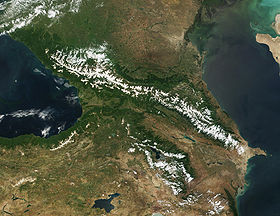This article needs additional citations for verification. (April 2023) |
| Caucasus Mountains | |
|---|---|
 Aerial view of the Caucasus Mountains | |
| Highest point | |
| Peak | Mount Elbrus |
| Elevation | 5,642 m (18,510 ft)[1] |
| Listing | Seven Summits |
| Coordinates | 43°21′18″N 42°26′31″E / 43.35500°N 42.44194°E |
| Dimensions | |
| Length | 1,200 km (750 mi) |
| Width | 160 km (99 mi) |
| Area | 477,165 km2 (184,234 sq mi) |
| Geography | |
| Countries | |
| Continent | Eurasia |
| Range coordinates | 42°30′N 45°00′E / 42.5°N 45°E |

The Caucasus Mountains[a] is a mountain range at the intersection of Asia and Europe. Stretching between the Black Sea and the Caspian Sea, they are surrounded by the Caucasus region and are home to Mount Elbrus, the highest peak in Europe at 5,642 metres (18,510 ft) above sea level.
The Caucasus Mountains include the Greater Caucasus in the north and the Lesser Caucasus in the south. The Greater Caucasus runs west-northwest to east-southeast, from the Western Caucasus on the northeastern shore of the Black Sea to close to Baku on the Caspian Sea, in Azerbaijan. The Lesser Caucasus runs parallel to the Greater about 100 km (62 mi) south.[2] The Greater and Lesser Caucasus ranges are connected by the Likhi Range, and to the west and east of the Likhi Range lie the Colchis Plain and the Kur-Araz Lowland respectively. The Meskheti Range is a part of the Lesser Caucasus system. In the southeast, the Aras River separates the Lesser Caucasus from the Talysh Mountains which runs through the Greater Azerbaijan region. The Lesser Caucasus and the Armenian Highland constitute the Transcaucasian Highland, which at their western end converges with the highland plateau of Eastern Anatolia. The Caucasus Mountains were part of the Silk Road.
- ^ "Topographic map of Mount Elbrus". opentopomap.org. Retrieved 2023-04-14.
- ^ Stokes, Chris R. (2011). Singh, Vijay P.; Haritashya, Umesh K. (eds.). Encyclopedia of Snow, Ice and Glaciers. Spring Science & Business Media. p. 127. ISBN 978-90-481-2641-5.
Cite error: There are <ref group=lower-alpha> tags or {{efn}} templates on this page, but the references will not show without a {{reflist|group=lower-alpha}} template or {{notelist}} template (see the help page).
